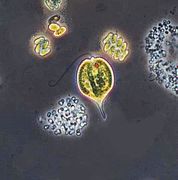Euglenophyceae
Euglenophyceae is a group of flagellated protists, commonly present in freshwater, especially when it is rich in organic matter. They are common organisms, with a cosmopolitan distribution, which are also found in the soil, in brackish mud and some in marine waters. They are unicellular, although sometimes they form colonies united by a gelatinous matrix, sessile or free. Most of its members have chloroplasts and are autotrophs, although some species have secondarily lost chloroplasts and are therefore heterotrophs. Euglenophyceans are protists that have achieved algal characteristics through endosymbiosis with a green alga. The typical genus is Euglena, a well-known unicellular alga.
Features
Euglenophidae are photosynthetic organisms, although some species have secondarily lost chloroplasts. They are especially abundant in eutrophic freshwater environments and are indicators of organic contamination. Several species inhabit brackish waters and estuaries, and a few lineages form part of marine plankton. They live in sediments or swimming in the water column.
They have variable shapes even within the same species: they are usually flagellated, but they can become immobile by changing shape, or becoming spherical and encysting. The cell presents an apical or subapical pocket or invagination consisting of a narrow channel and a reservoir. In this pocket the flagella are inserted. There may be two equal or unequal flagella, the second flagellum may also be shorter and attached to the base of the long flagellum; some species have more than two flagella. Normally the emerging flagellum presents a row of mastigonemas. A stigma or eyespot may appear, with a light-sensitive photoreceptor.
They lack a cell wall, but have a film that covers the cell or proteinaceous periplast within the plasma membrane. The periplast, which may be ornamented, is made up of a set of bands fitted one inside the other in such a way that they allow sliding by contraction and expansion movements. Underneath are microtubules and mucilage vesicles involved in the formation of the periplast. Sometimes mucilage is produced externally, forming a lorica.
Asexual reproduction is by bipartition, even when they are in the flagellate phase. First there is a duplication of all the organelles and then cytokinesis following the helical lines of the periplast bands. When conditions are not favourable, they become encysted and germinate when they are favourable. No sexual reproduction has been observed.
The classification is based on the arrangement of the flagella, except for one genus, which is sessile, Colacium, which keeps its flagella in the reservoir. Some strains of Euglena gracilis are used as indicators of vitamin B12 in the medium.
Chloroplasts
The photosynthetic species present chloroplasts supposedly acquired by secondary endosymbiosis of a prasinophyte green alga of the Pyramimonadales group, since they are surrounded by three membranes and contain chlorophylls a and b > Chloroplasts occur in groups of three to twelve, while thylakoids form groups of two to six, usually in groups of three. Chloroplasts can be lenticular, ribbon-shaped, reticulate, or stellate. As accessory pigments they present β-carotene and xanthophylls. Among the latter are astaxanthin, which gives them a reddish color, hematochrome, for example in Euglena sanguinea, which gives a red color to the water in which it lives, and euglenorodone.
As reserve material they accumulate paramyle (a beta-1-3-glucan, linear aggregation of glucose), which appears in large corpuscles, a few per cell. They also accumulate chrysolaminarin, which is also a beta-1-3-glucan, but branched. A pyrenoid may appear, where the reserve material is formed. The paramyle that can be inside or outside the cells, depending on the gender.
If the euglenas are placed in the dark, they lose their plastids, remaining in the form of proplastids, which will re-pigment with light.
Classification
Within the Euglenophyceae there are two orders:
- Euglenales. They present a single emerging scourge, as the latter is very short and does not stand out from the apical pocket, or the two scourges are not emerging. They usually live in sweet and sweet habitats and in addition to photosynthetic species also include non-colored.
- Euthreptials. They are distinguished from the other order in which they present two to four emerging, equal or unequal scourges and are fundamentally marine or saltwater. In addition, all members of the group are photosynthetic, while euglenals also include non-colored species.
- Raptor. Baseline genus of euglenophics. Unlike the orders described as phototrophos, Raptor is mixed-tropho with eukaryovora capacity.





